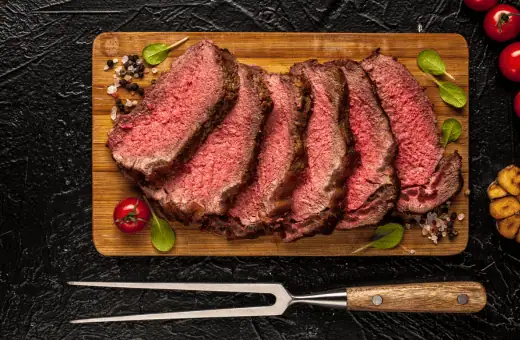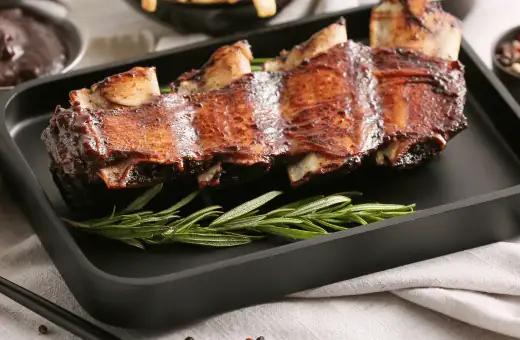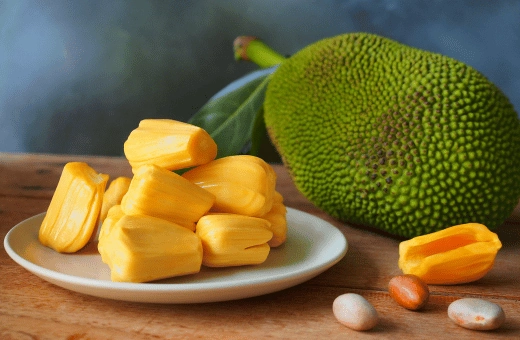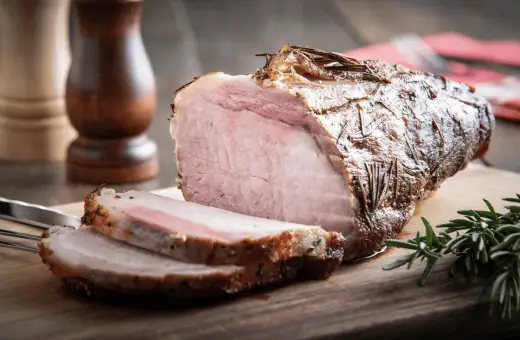Are you looking for quick and easy substitutes for pork shoulder?
Pork shoulder is a versatile cut of meat that can be cooked in various ways to create delicious and succulent dishes.
But sometimes, you might not have this cut of meat on hand or want to change things up.
In this article, we’ve compiled a list of the top 15 pork shoulder substitutes and how to use them for your next meal.
These alternatives will undoubtedly bring the same meaty flavor and texture you crave without compromising taste and quality.
So, let’s get started!
In short, "What can I use instead of pork shoulder?" Beef Chuck Roast, Lamb Shoulder, Beef Short Ribs, Turkey Thighs, Venison Shoulder, Brisket, Pork Tenderloin, Beef Brisket Flats, Bison Chuck Roast, Venison, Jackfruit, Turkey breast, Seitan, Tofu, Pork loin.
What is pork shoulder, and what does pork shoulder taste like?
The pork shoulder is a stake of meat from the front part of a pig. It comes from the area between the neck and forelegs and includes several muscles and parts associated with it.
Pork shoulder is also an excellent source of protein and various other nutrients, including iron, zinc and selenium.
Additionally, pork shoulder contains B vitamins which are important for maintaining energy levels throughout the day as well as aiding in healthy skin and hair growth.
Pork shoulder is most commonly used to make pulled pork dishes, as its marbling gives it both tenderness and flavor.
When cooked properly, pork shoulder has an incredibly juicy, succulent texture with a nuanced hint of smokiness that pairs well with other bold flavors.
It can be braised or roasted slowly in a low oven so that the fat renders off and the meat becomes fall-apart tender.
The resulting flavor is intense yet mellow, rich but not heavy, with crispy edges that contrast nicely against the moist interior.
In terms of taste, pork shoulder has a slightly sweet flavor that pairs well with a range of spices and herbs. It’s often seasoned with garlic, smoked paprika, oregano or rosemary.
For the best results, allow the meat to absorb these flavors overnight before cooking it slowly over low heat until it is meltingly tender.
Enjoy your delicious pork shoulder dish hot off the stove or chill it for use in pulled pork sandwiches, tacos or salads – you won’t regret it!
Enjoying pork shoulder doesn’t require any special culinary skills; all it takes is patience and simple seasonings.
Whether you’re cooking a summer barbecue or making a winter stew, pork shoulder is worth the effort. Give it a try – you won’t be dissatisfied!
What are the Uses of pork shoulder?
Pork shoulder is a versatile cut of meat with numerous uses. It can be slow-cooked, pulled into shredded BBQ, roasted in the oven, or grilled on a barbecue.
The marbling of fat and connective tissue throughout the pork shoulder gives it a great flavor while cooking, resulting in juicy cooked meat that easily falls apart.
This makes it ideal for making pulled pork sandwiches, tacos, burritos, stews, or even as an addition to soups or omelets.
Pork shoulder is also popular for curing and smoking to make bacon or ham.
A typical pork shoulder can weigh four to seven pounds before cooking and shrinks down to approximately half this weight after being cooked.
Best Substitute for Pork Shoulder
1. Beef Chuck Roast

Beef chuck roast is a great substitute for pork shoulder. It is a flavorful and tender cut of meat that can be braised, roasted, or slow-cooked.
Ratio or measurement: The ratio of chuck roast to pork shoulder is 1:1. Use the same cooking method as you would for pork shoulder.
2. Lamb Shoulder
Lamb’s shoulder is another great option that offers a rich and unique flavor. It can be braised, roasted, or slow-cooked, and it is a great match for Middle Eastern or Mediterranean recipes.
Ratio or measurement: Use the same cooking method as you would for pork shoulder.
3. Chicken Thighs
Chicken thighs are a perfect alternative for pork shoulder when you need a quick fix. They are juicy and succulent and have a similar texture to pork shoulder.
Ratio or measurement: The ratio of chicken thighs to pork shoulder is 1.5:1.
Use the same cooking method as you would for pork shoulder.
4. Beef Short Ribs

Beef short ribs are one of the best substitutes for pork shoulder. They are a fatty and flavorful cut of meat that is perfect for braising or slow cooking.
Ratio or measurement: The ratio of beef short ribs to pork shoulder is 1:1.
Use the same cooking method as you would for pork shoulder.
Discover: Short Rib Substitutes/Cheap/Beef-free & Vegan Alternative
5. Turkey Thighs
Turkey thighs are another alternative and offer a great taste without sacrificing nutritional value. They are leaner than pork shoulder, making them a healthier option.
Ratio or measurement: The ratio of turkey thighs to pork shoulder is 1.5:1.
Use the same cooking method as you would for pork shoulder.
6. Venison Shoulder
Venison shoulder is a fantastic substitute for pork shoulder and offers a unique flavor. It is leaner than pork and has a gamey taste.
Ratio or measurement: The ratio of venison shoulder to pork shoulder is 1:1.
Use the same cooking method as you would for pork shoulder.
7. Brisket
Brisket is a popular cut of meat used for BBQ, but it can also be used as a replicate for pork shoulder.
It is a tough amount of meat that requires a slow and low cooking method to become tender and succulent.
Ratio or measurement: The ratio of brisket to pork shoulder is 1:1.
Use the same cooking method as you would for pork shoulder.
8. Pork Tenderloin

Pork tenderloin is a lean cut of meat that can be roasted or grilled. It has a milder flavor than pork shoulder but still offers the same texture.
Ratio or measurement: The ratio of pork tenderloin to pork shoulder is 2:1.
Use the same cooking method as you would for pork shoulder.
9. Beef Brisket Flats
You can use Beef brisket flats as a substitute for pork shoulder. It is a leaner cut of meat that requires slow cooking to become tender and flavorsome.
Ratio or measurement: The ratio of beef brisket flats to pork shoulder is 1:1.
Use the same cooking method as you would for pork shoulder.
10. Bison Chuck Roast
Bison chuck roast is an excellent substitute for pork shoulder as it has a sweet and rich flavor. It is a leaner cut of meat that is perfect for grilled or roasted dishes.
Ratio or measurement: The ratio of bison chuck roast to pork shoulder is 1:1.
Use the same cooking method as you would for pork shoulder.
11. Venison
If you want to try something more exotic, venison is an interesting substitute for pork shoulder. It’s lean and rich in flavor, which makes it ideal for hearty stews or chili recipes.
Ratio or measurement: Use the same ratio as pork shoulder, and marinate it overnight for best results.
12. Jackfruit

For a vegan option, jackfruit is an interesting and versatile substitute for pork shoulder.
It has a meaty texture and can absorb flavors well, making it perfect for dishes like vegan pulled pork or tacos.
Ratio or measurement: Use about the same amount as pork shoulder and season with your favorite spices or BBQ sauce.
13. Turkey breast
If you have leftover turkey from Thanksgiving, it can be used as a pork shoulder substitute in a variety of dishes. It’s lean and mild-tasting, which makes it perfect for healthy and light meals.
Ratio or measurement: Use the same ratio as pork shoulder, and cook on low heat for about 30-40 minutes.
14. Seitan
Another vegan option, seitan, is a wheat-based protein that can mimic the texture and flavor of the meat. It works well in dishes like vegan stews, curries, or vegan sandwiches.
Ratio or measurement: Use the same ratio as pork shoulder, and season to your liking.
15. Tofu
For a low-calorie and low-fat option, you can use tofu as a substitute for pork shoulder in some dishes. It’s low in flavor but can absorb flavors well, making it ideal for stir-fries or vegan BBQ.
Ratio or measurement: Use about half the amount that the recipe calls for pork shoulder, and cook on high heat for a few minutes.
Pork loin instead of shoulder
Pork loin is a leaner, more tender cut of pork compared to pork shoulder. It’s also said to have a milder flavor, making it great for marinating and adding herbs or other seasonings to enhance its taste.
Pork loin is significantly leaner than pork shoulder, with almost half the amount of fat.

This creates it an excellent option for those searching to incorporate lean proteins into their diet while still enjoying the delicious taste of pork. It’s also a useful source of iron and B vitamins.
When cooked properly, pork loin is juicy and succulent, with a slightly sweet flavor that goes well with many dishes.
The key to cooking pork loin correctly is keeping it moist during cooking by using brining or basting techniques like marinating or slow-cooking.
Beef substitute for pork shoulder
Beef can be a great substitute for pork shoulder in many dishes. It is often the preferred meat when making tacos, burritos, and other Mexican-style dishes.
Beef tends to have a bolder flavor than pork, with a thicker texture that holds up better when cooked. It also has slightly higher levels of fats and proteins, making it a great source of energy.
When substituting pork shoulder for beef, the best cut of beef to use is a chuck roast.
Chuck roast arrives from the shoulder area of the cow and is full of rich, flavorful fat, which helps keep the meat juicy and tender when cooked.
It is best cooked low and slow, either in a crockpot or Dutch oven, to bring out the full flavor profile.
The meat should be cooked until it reaches an internal temperature of at least 145°F (medium-rare) and can be served either sliced or shredded accordingly.
Chuck roast pairs well with root vegetables like potatoes and carrots, as well as robust sauces such as barbecue, red wine, and Italian herbs.
When using this cut of beef as a pork shoulder substitute, keep in mind that it may take longer to cook due to its higher fat content.
Boneless pork shoulder substitute
Pork butt, sometimes called Boston butt, is a great substitute for boneless pork shoulder. It comes from the same part of the pig and has an almost identical flavor profile and texture.
The pork butt has some fat marbling that helps keep it moist when cooked.
The dissimilarity between pork butt and pork shoulder is that the cut from the butt does not have bones, unlike the shoulder cut.
This makes it easier to handle and cook than its bone-in counterpart.
When cooked low and slow, pork butt shatters down into tender, juicy strips of meat that are perfect for tacos, barbecue sandwiches, or any other dish that calls for pulled pork.
Pork shoulder substitute for pulled pork
A great alternative to pulled pork is pork shoulder, also known as pork butt or Boston butt. This cut of meat can be slow-cooked in the oven or slow cooker until it’s tender and shreds easily.
Pork shoulder is full of flavor, with its higher fat content helping to keep the meat moist during cooking.
When cooked low and slow, the fat melts away, and the collagen breaks down to create a juicy, flavorful dish.
It’s perfect for sandwiches or tacos, as well as with your favorite barbecue sauce.
Pork shoulder can also be used in stews and soups, adding great depth of flavor. Cooking pork shoulder is easy — just season with salt and pepper before cooking, and add your preferred seasonings or flavors.
Be sure to cook the pork until it reaches an internal temperature of 145°F (63°C) before serving.
With a little effort, you can create delicious pulled pork dishes with pork shoulder that will have everyone asking for seconds!
Pork shoulder substitute carnitas
Carnitas is a classic Mexican dish that is perfect for any occasion. Pork shoulder is commonly used to make carnitas; however, beef chuck roast can also be used.
The chuck roast is a tougher cut of meat that has more marbling and collagen than the pork shoulder, which helps create a juicy and tender texture when braised.
The beef chuck roast also has a more intense flavor that pairs perfectly with the bold flavors of Mexican spices, such as cumin and chili powder.
When preparing beef chuck roast for carnitas, it is important to slowly cook the meat in a flavorful liquid until it is fork-tender.
Once cooked, the meat can be shredded and used in tacos, burritos, enchiladas, nachos or any other dishes that require carnitas.
For a truly authentic Mexican flavor, serve the beef chuck roast carnitas with homemade salsa, guacamole and warm tortillas.
Serve the carnitas with warm tortillas, diced avocado, shredded cheese, and all your favorite toppings. Enjoy!
Pork shoulder substitute tacos
Substituting pork shoulder with an alternative protein in tacos can be a great way to mix up the flavors and texture of your favorite dish.
One popular option is to replace pork with chicken or beef. The meat should be cooked before adding it to your tacos, such as baking, stir-frying, or grilling it.
You may also want to add some seasonings and spices to enhance the flavor.
Other vegetarian options include black beans, jackfruit, tempeh, lentils, tofu, or seitan for a hearty taco that’s sure to satisfy.
Topping your tacos with fresh vegetables such as lettuce, tomatoes, onions and peppers will give them an extra crunch and flavor.
Finally, don’t forget to also add your favorite salsa or guacamole for an extra burst of flavor! Enjoy!
Slow cooker pork shoulder substitute
Pork shoulder is an ideal cut of meat for slow cooking due to its high-fat content and marbled texture, which helps to keep the meat tender and juicy during long cooking times.
If pork shoulder isn’t available, a good substitute would be a boneless pork butt or Boston butt.
This cut of meat comes from the same part of the pig, but since it is boneless, it does not require as long of a cooking process.
When slow-cooked properly, pork shoulder can be extremely tender and juicy.
Many recipes suggest braising or stewing the meat to keep its moisture locked in while rendering out some of the fat for a more flavorful meal.
Pork shoulder can also be used in soups, sandwiches, tacos, or any other dish that requires slow-cooked meat.
For those who are looking for a leaner cut of pork, the loin can be substituted as well.
There are many different methods to prepare pork shoulder, from roasting and barbecuing to simply simmering it in broth.
Where to buy pork shoulder?
There are a few various places you can go. Many specialty food stores carry it, as do some international grocery stores.
You can also order online from many retailers that provide a variety of diverse flavors and types of zero pork shoulder.
Conclusion on pork shoulder substitute
In conclusion, pork shoulder is a delicious and versatile cut of meat, but there are plenty of alternatives if you don’t have it on hand or would like to try something new.
By using our list of 15 substitutes, you can cook up a storm with confidence and with the same meaty flavor and texture you crave without compromising taste and quality.
With these ideas, you can explore new cuisines and create delicious dishes that your family and friends will love!
FAQs on Pork Shoulder Substitute
Q1. What is similar to pork shoulder?
Pork butt and pork shoulder are very similar cuts of meat. The pork butt is cut from the upper part of the shoulder, while the pork shoulder is cut from the lower section.
Both cuts are extremely versatile and can be cooked in a variety of ways, such as roasting, braising, smoking, or barbecuing.
The main difference between the two cuts of meat is that pork butt has slightly less fat and therefore takes less time to cook. Both cuts are great for making pulled pork!
Q2. What beef cut is equivalent to pork shoulder?
The beef cut that is most equivalent to pork shoulder is the chuck roast. It comes from the shoulder area of a cow and has similar marbling, texture, and flavor as pork shoulder.
However, due to its leaner nature, it requires slightly different preparation and cooking methods than pork shoulder.
Chuck roast can be slow-cooked or braised to bring out its flavor and tenderness, just like pork shoulder. It also can be used in recipes that call for ground beef or diced into cubes for stews and other dishes.
Chuck roast is a multipurpose cut of beef that can be enjoyed in many different ways. When buying chuck roast, look for one with good marbling and no signs of drying out. This will ensure that the final dish is both flavorful and succulent.
With a little bit of creativity, chuck roast can make an excellent substitution for pork shoulder in most recipes!
Q3. Can pork loin substitute for pork shoulder?
Pork loin and pork shoulder are two cuts of meat that come from the same animal, but they have some significant differences. Pork loin is a long, tender cut of meat from the back of the pig, while pork shoulder is a fattier cut that comes from the front of the hog.
Because of its higher fat content, pork shoulder can be cooked for longer periods at lower temperatures to achieve maximum tenderness and flavor.
This makes it an ideal choice for slow-cooked dishes like stews or pulled pork. On the other hand, pork loin should be cooked quickly over high heat in order to remain tender and juicy.
The fat content also means that pork shoulder has more flavor than leaner cuts like loin, making it an ideal choice for dishes where you want to really bring out all the subtle nuances in the meat.
While pork loin can be substituted in some recipes when time is limited or if you need a leaner cut of meat, it likely won’t provide as much flavor as a true slow-cooked dish with pork shoulder.
Q4. Can I substitute pork chops for pork shoulder?
It is possible to substitute pork chops for pork shoulder, although the result may not be as tender and flavorful. Pork shoulder is a marbled cut of meat that contains a higher percentage of fat, which helps keep it moist and renders out during cooking to add flavor.
By contrast, pork chops are usually leaner cuts with less fat content. As a result, they tend to dry out quicker and lose more moisture when cooked. Additionally, the marbling of fat in pork shoulder helps to add flavor, adding an extra boost compared to leaner cuts like pork chops.
That said, if you are in a bit and need to use pork chops instead of pork shoulder, there are a few tricks to help ensure that your dish turns out as flavorful as possible. First, be sure to cook the chops over low heat and avoid overcooking them.
Additionally, you can add some additional fat (such as oil or butter) during cooking in order to help keep the meat moist. Finally, adding some extra spices or herbs can also help enhance the flavor of the dish.
Ultimately, while substituting pork chops for pork shoulder may not produce exactly the same results as using pork shoulder itself, these tips can help make sure that your meal still comes out delicious!

